Participants: Volodin I.A., Volodina E.V., Frey R.
Funded by Russian Foundation for Basic Research (RFBR, grant 12-04-00260a).
Saiga is the single trunk-nosed antelope. Similar to elephants, saigas vocalize through the nose and through the mouth, thus representing an excellent model for comparison of the acoustics of nasal and oral calls. Because of the trunk, the way of the sound wave from the vocal folds to the out from the nose exceeds by the length the way to the mouth opening, what allows direct estimating the acoustic effects of the vocal tract length on the calls.
All sex and age-classes of saigas vocalize. Adult males during the rut vocalize only through the nose, pressing it preliminary from the sides. During the calling, the nose additionally extends forward by about 20 percent, and this elongation results in further decrease of vocal resonances (formants) of the nasal vocal tract, so that male vocalizations are apparently sound as calls of a large-sized animal
(Frey et al., 2007 151.pdf; Âîëîäèíà, Âîëîäèí, 2008 412.pdf; Âîëîäèí è äð., 2009 164.pdf). Adult females and their young vocalize either through the nose or through the mouth (Volodin_et_al., 2009 164.pdf; Volodin et al., 2014 199.pdf). The acoustic structure of nasal and oral calls is pronouncedly different, so is interesting, what acoustic traits allow mother and offspring to find each other in dense aggregations (Volodin et al., 2014 199.pdf).
To date, we only studied the saiga acoustic behaviour in captivity, where both vocal behaviour and the acoustic traits might differ from the naturally occurring sounds. So, we were lucky to join the expedition to saiga breeding grounds in Kazakhstan in May 2014. In May 2014, the saiga population on Kazakstan counted about 200000 animals, what is much larger than in endangered saiga population in Kalmykia. The expedition was organized by an Association on Protection Biodiversity of Kazakhstan. Aside us, the addition participants of the expedition were specialists on wild animal diseases from the Institute of Biological Safety of Kazakstan, from the London Royal Veterinary College of Great Britain, as well as a specialist on vocal anatomy of ungulates from the Institute of Zoo and Wildlife Research (Berlin, Germany).
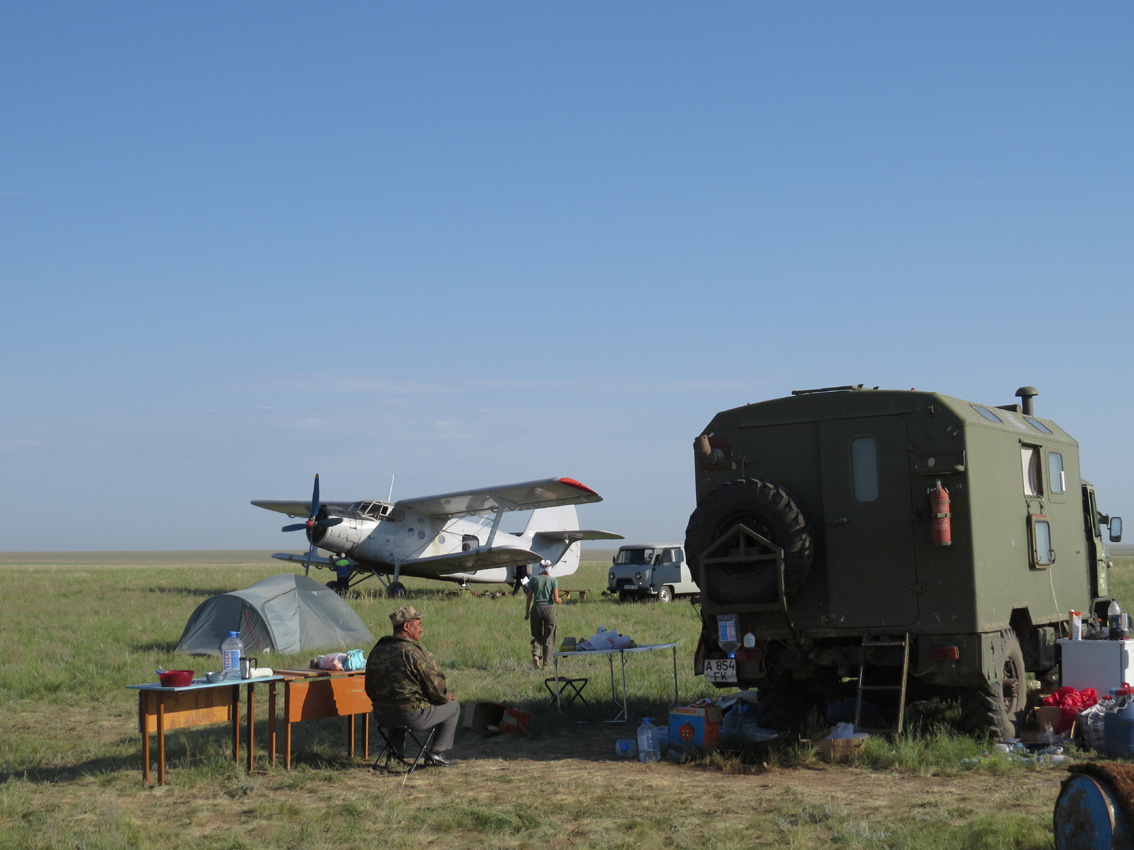
1. Estate car and the plane
Throughout the April, this plane AN-2 has been working on saiga counts. There are three isolated populations of saiga in Kazakhstan: Usturt, Volga-Ural (coming to the territory of Russia), and the largest one Betpakdala, that is split to a few subgroups. The saigas are remarkable with their lifelong wandering. One hundred kilometers per day is not a problem for them. Only during the breeding, they concentrate in a few places, where within a few days all females give birth. The factual places of breeding among the tremendous steppes are unpredictable. So, for monitoring and counts of large saiga aggregations, the planes are strictly necessary. The purpose of our expedition is the group of saigas, counting about 30-40 thousands of pregnant females, of the Betpakdala population wandering over the Turgai steppe.
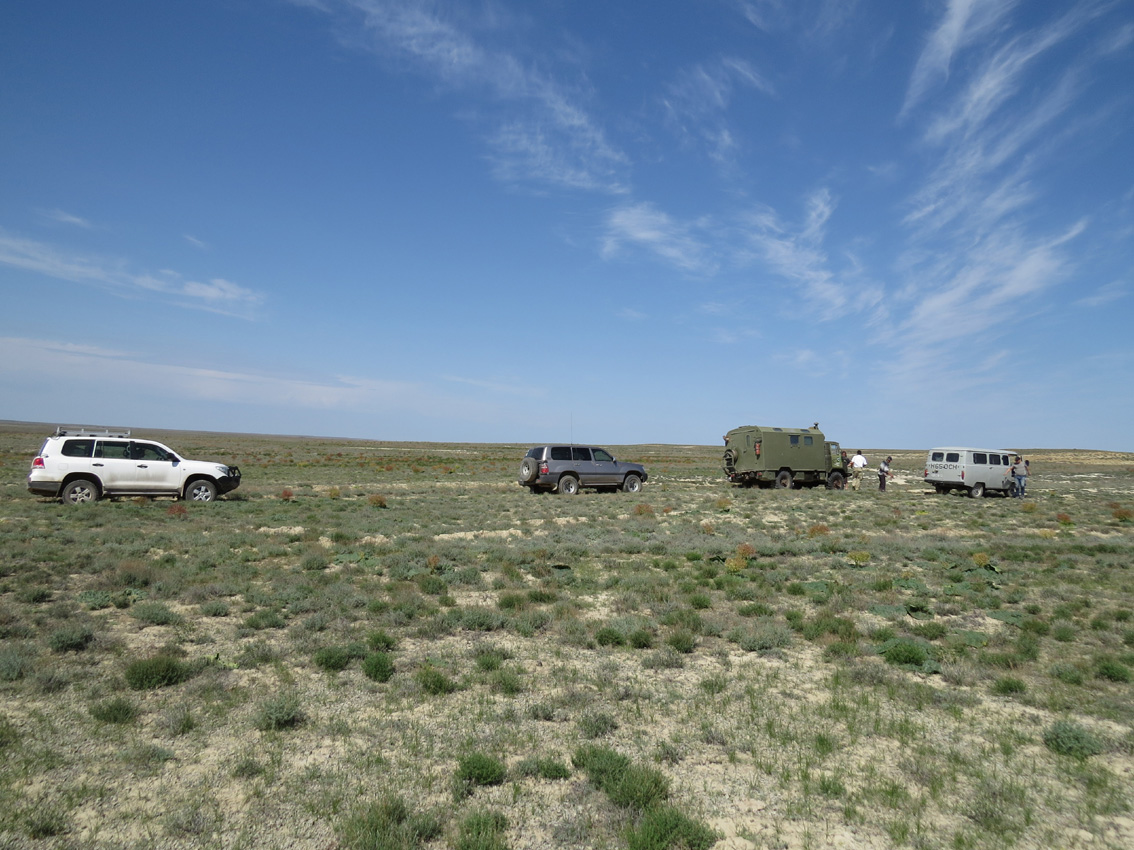
2. Expedition car column
The expedition to saiga breeding grounds is on the column of cars, supporting connection with radio. The way to saigas is far, with two nights, one in a small hotel near the road and another one in tents just in the steppe. By the road, we buy the food and collect the water, as no drinking water is available on the place.
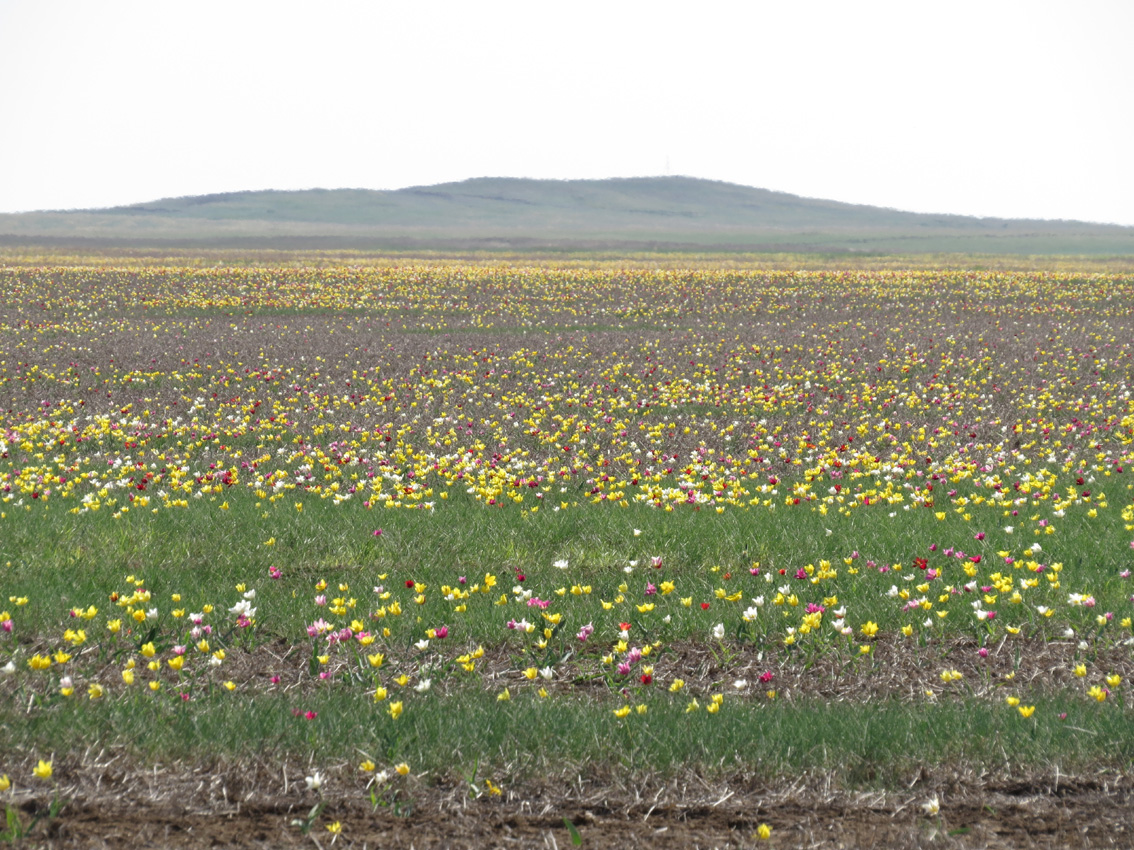
3. Tulip field
Fields of flourishing tulips can be observed only within first ten days of May. The flowers vary in colors from white and yellow to pink and raspberry, although this is the same species, the Schrenck' tulip (Tulipa schrenkii in Latin). This information is received from the botanist of our expedition, Tatyana Sidorova. The Schrenck' tulip is poisoning, but probably not for saigas. Pregnant saiga females are very selective in their food, but the tulips are among their favoirite snacks. We met many tulips with flowers bitten by saigas.
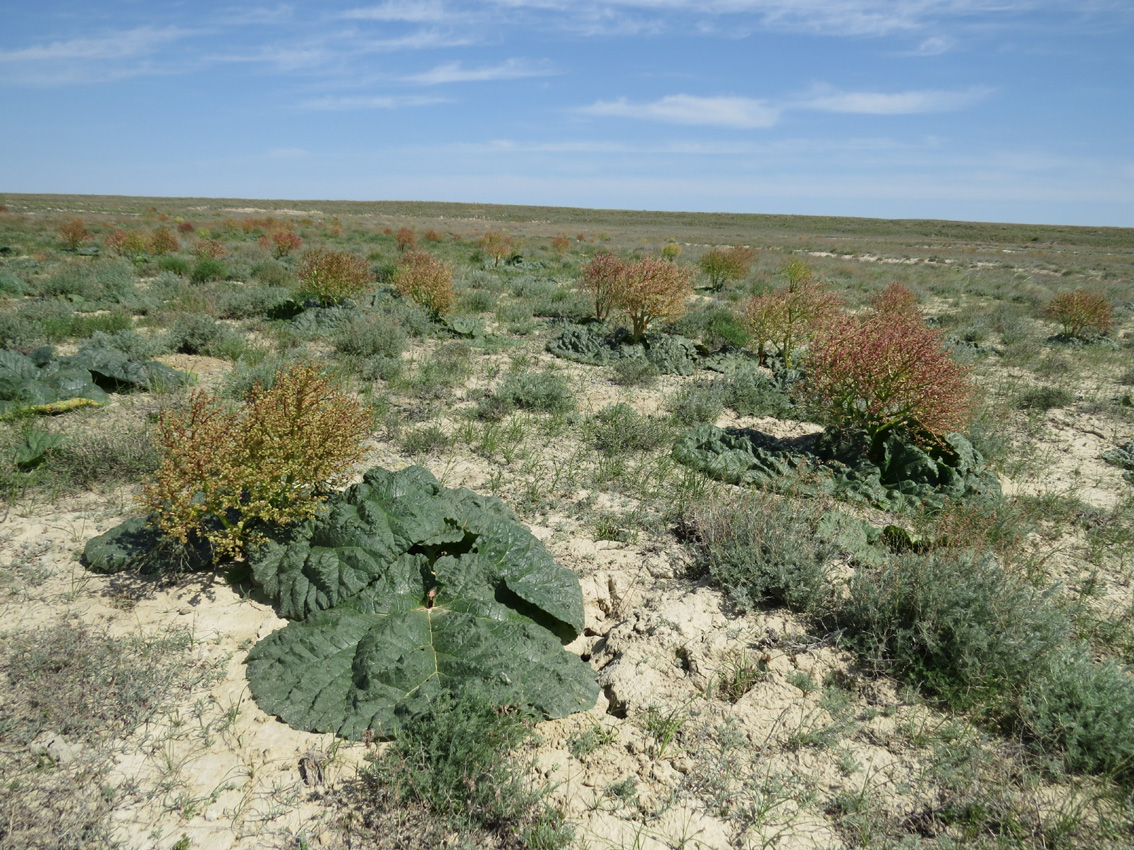
4. Field of Rheum tataricum
Saigas often give birth to the young at fields of Rheum tataricum. This occurs, when large leaves of Rheum tataricum start getting yellow, and newborn saigas are very similar to these leaves by color and size.
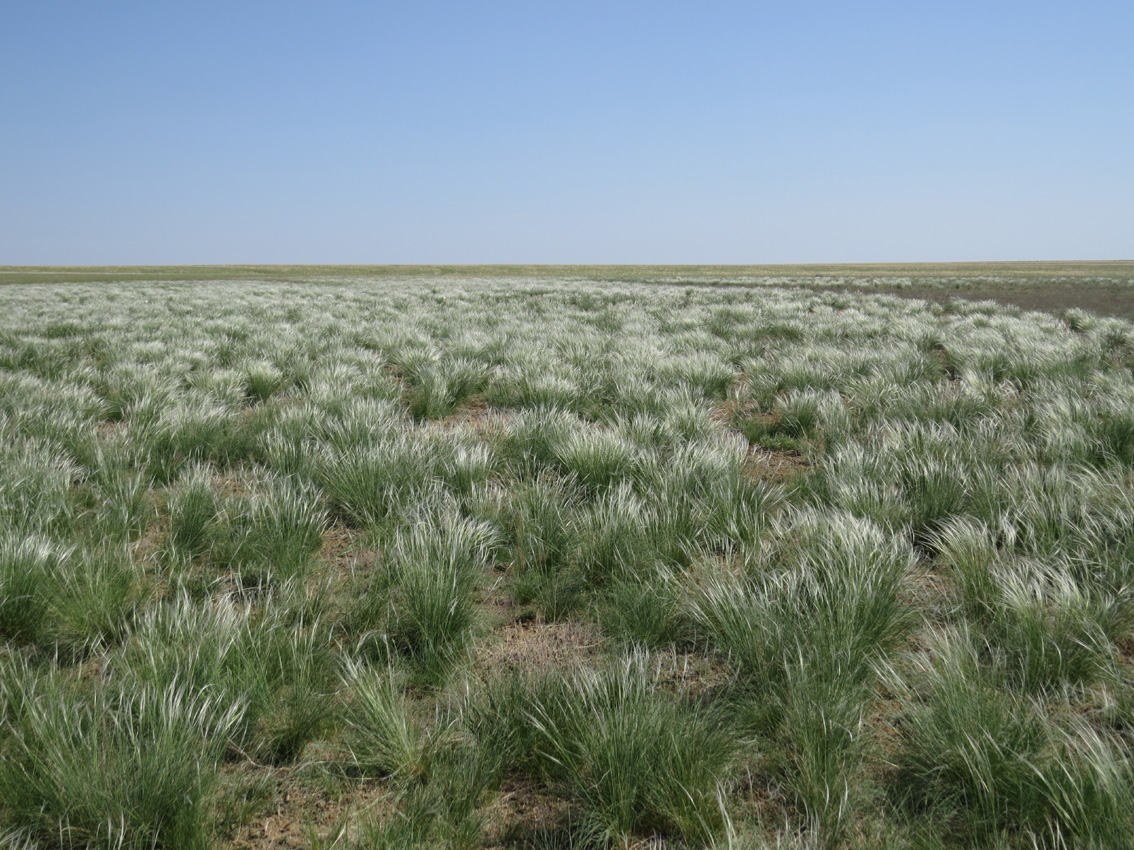
5. The Stipa grass
Saigas do not eat the Stipa grass, and do not stay at places with it, passing further.
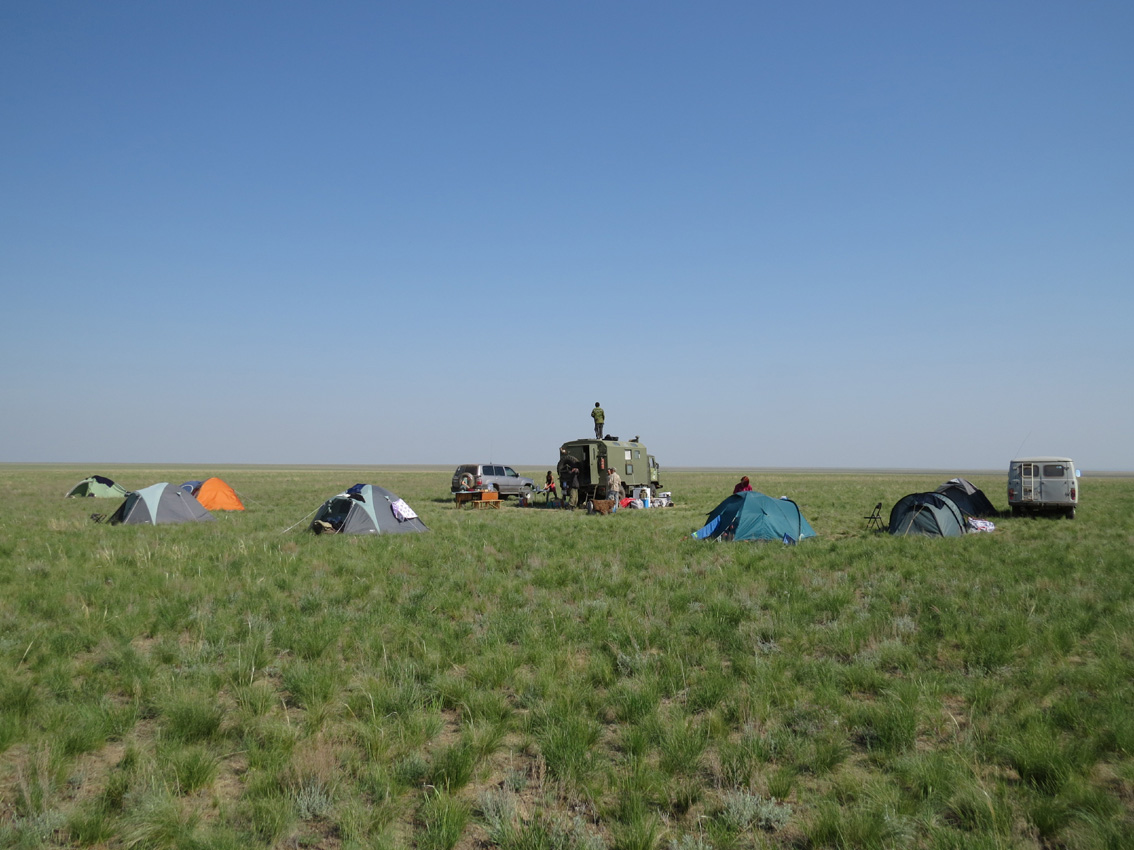
6. Expedition tent campus
Expedition tent campus was made just in the steppe. Purposely was selected a place in a couple of kilometers from a water post, made some time for eves. Although it is necessary to drive for the technical water for washing dishes and other needs, a plenty of mosquitoes force to hide from them only in a tent or on the estate car. There are billions of mosquitoes near the water.
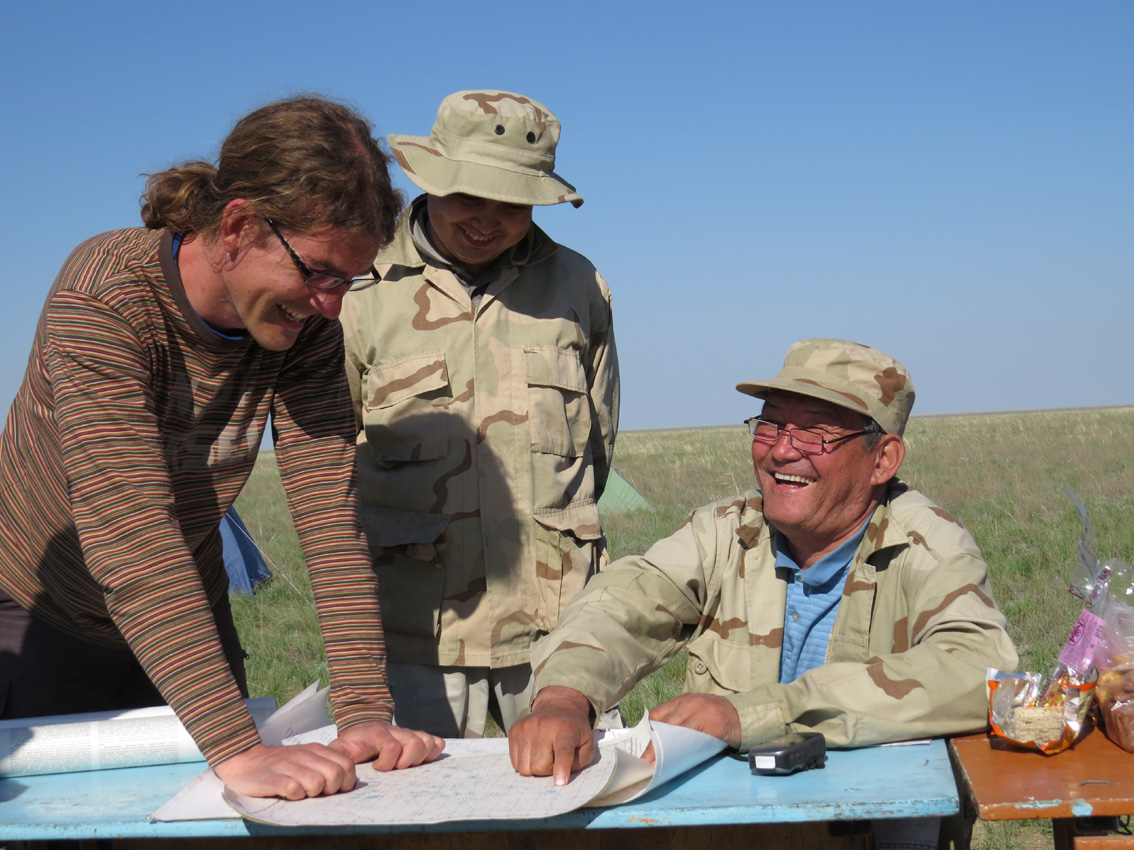
7. Location of saiga herd
Chiefs of the expedition adjust the location of saiga herd for future counts. Location the herd occurs with Internet geo-information technology, following females marked with satellite collars. Before the mass parturitions, the herd of pregnant females start moving more and more slowly, making circles over a large radius of a few kilometers around a certain place. A few females from this herd are labeled with the satellite collars, and by their coordinates, location of all the herd can be established. After that, the expedition chiefs create the ruts of transects 60 meters wide and 10 km long, for further censuses of newborn saigas.
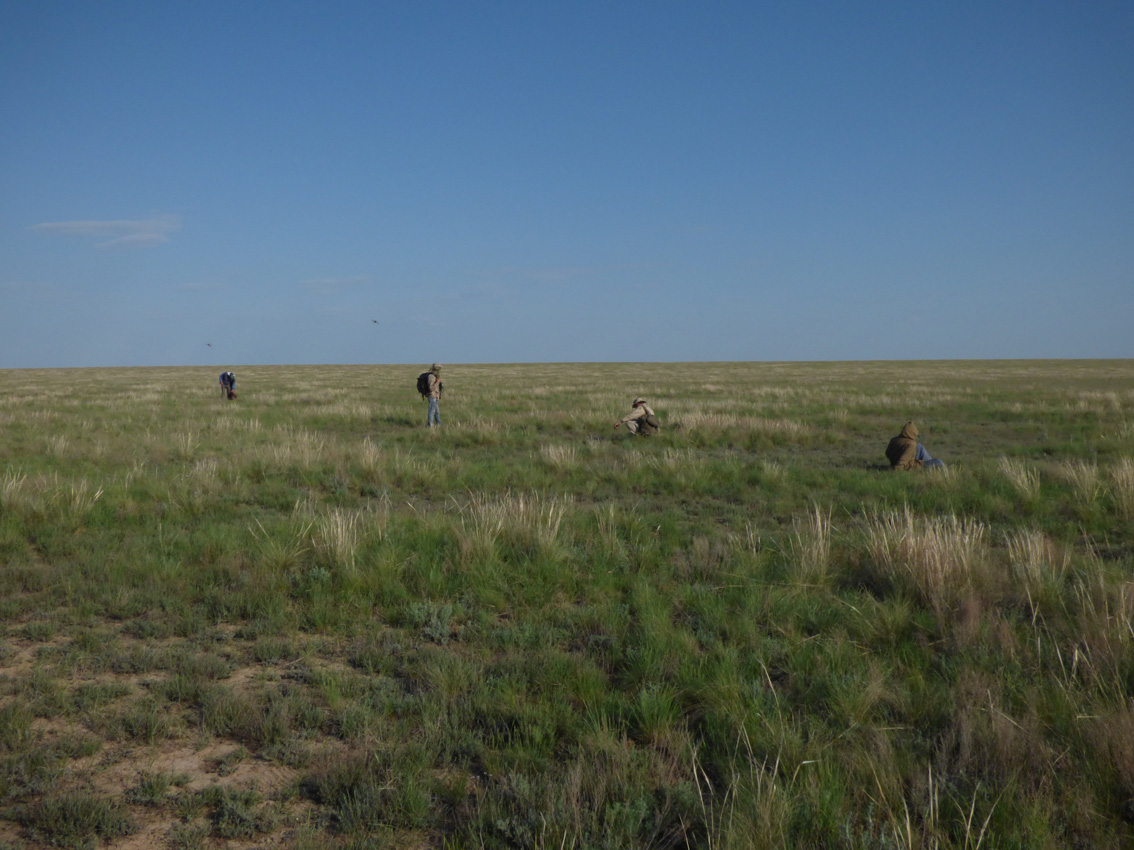
8. Human counters at the transect
Period of mass parturitions slightly varies by dates depending on a year or for different saiga herds at the same year. So, monitoring of transects starts before the period of mass parturitions. The car is left at 3 km from the breeding grounds, to avoid frightening the females or car accident with the hider saiga young. So, the counters should walk for many hours by transects and for returning to the car. During the first count for 27 km along the hummock steppe, our team found only 34 newborn saigas.
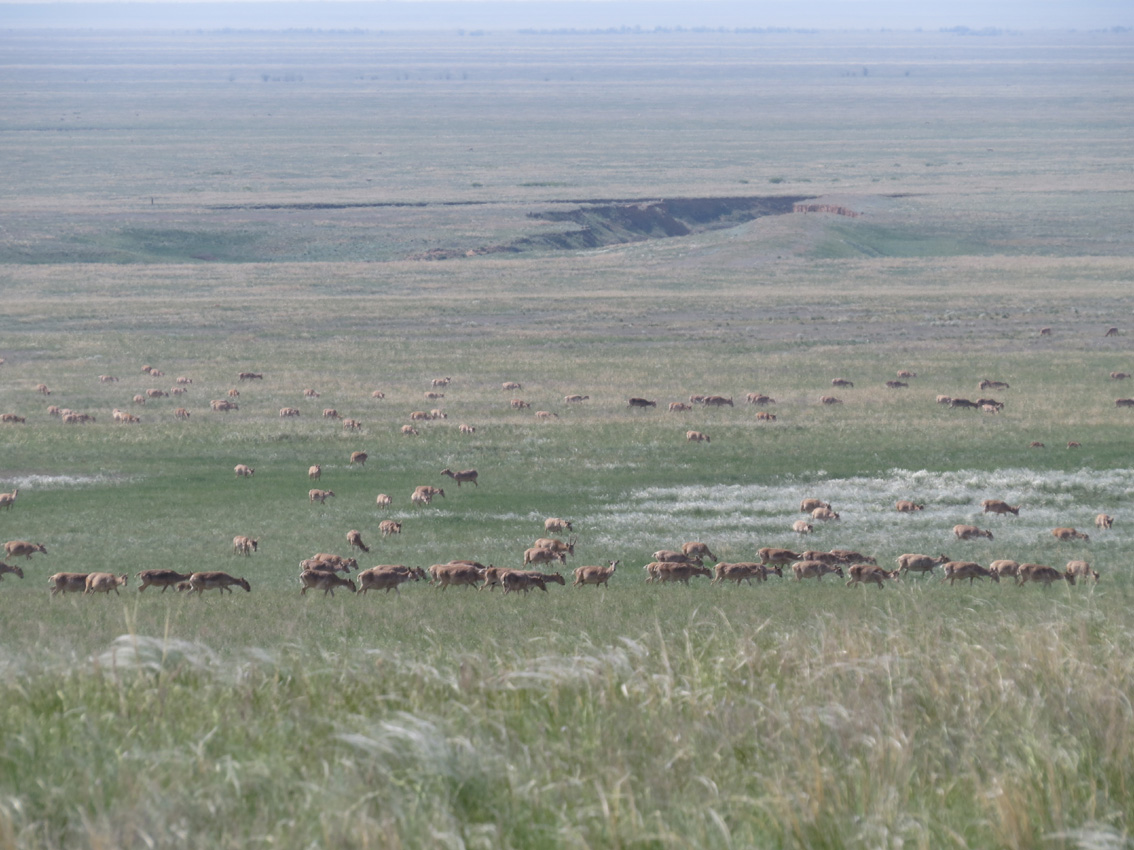
9. The herd of pregnant saiga females
Saiga females are always at some distance to people, not close 500-600 m. Early in the morning, the saiga herd moves fast and scattered; during the moving, the animals manage to graze.
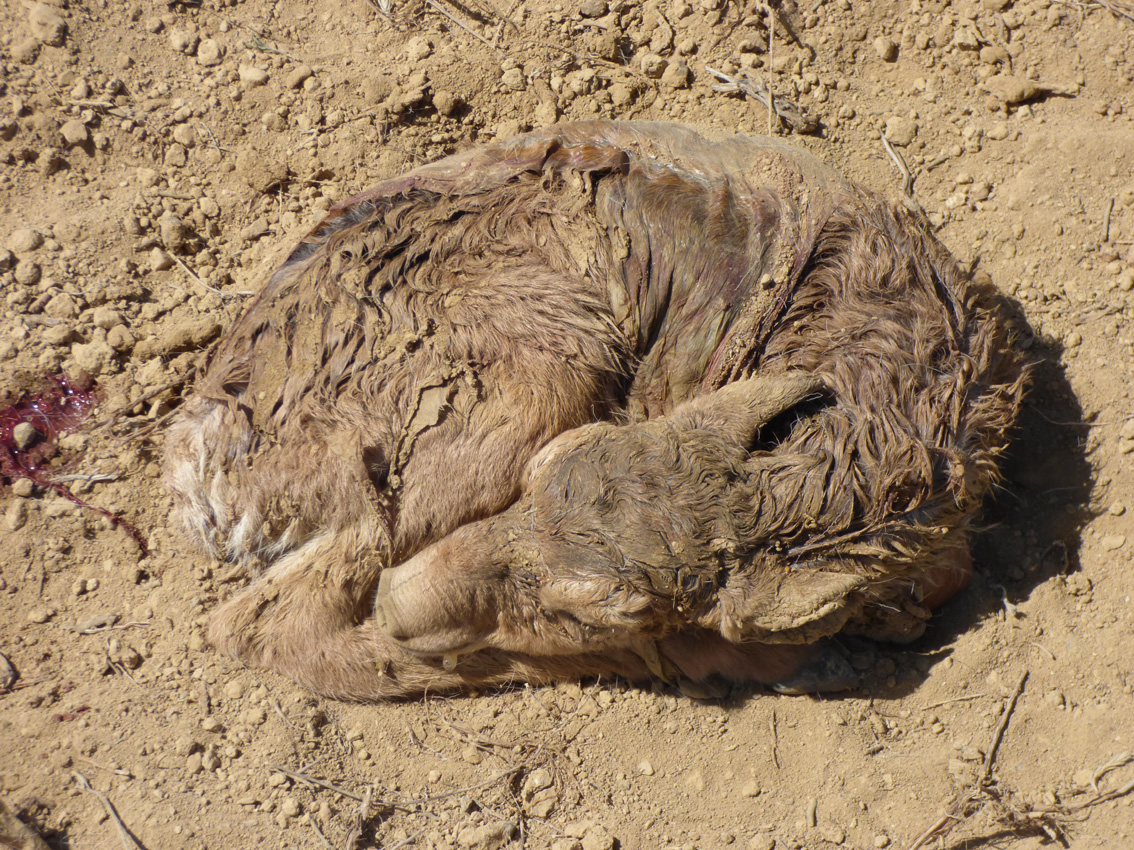
10. Saiga newborn
This saiga newborn was born within hour. It is already free of amniotic membranes, but yet perfectly wet. A mother leaves the young immediately after parturitions, and left the newborn drying. Lying nearly immobile means a single chance for the young to be not detected by predators and to retain enough energy while waiting for its mother, which will return later, to feed it.
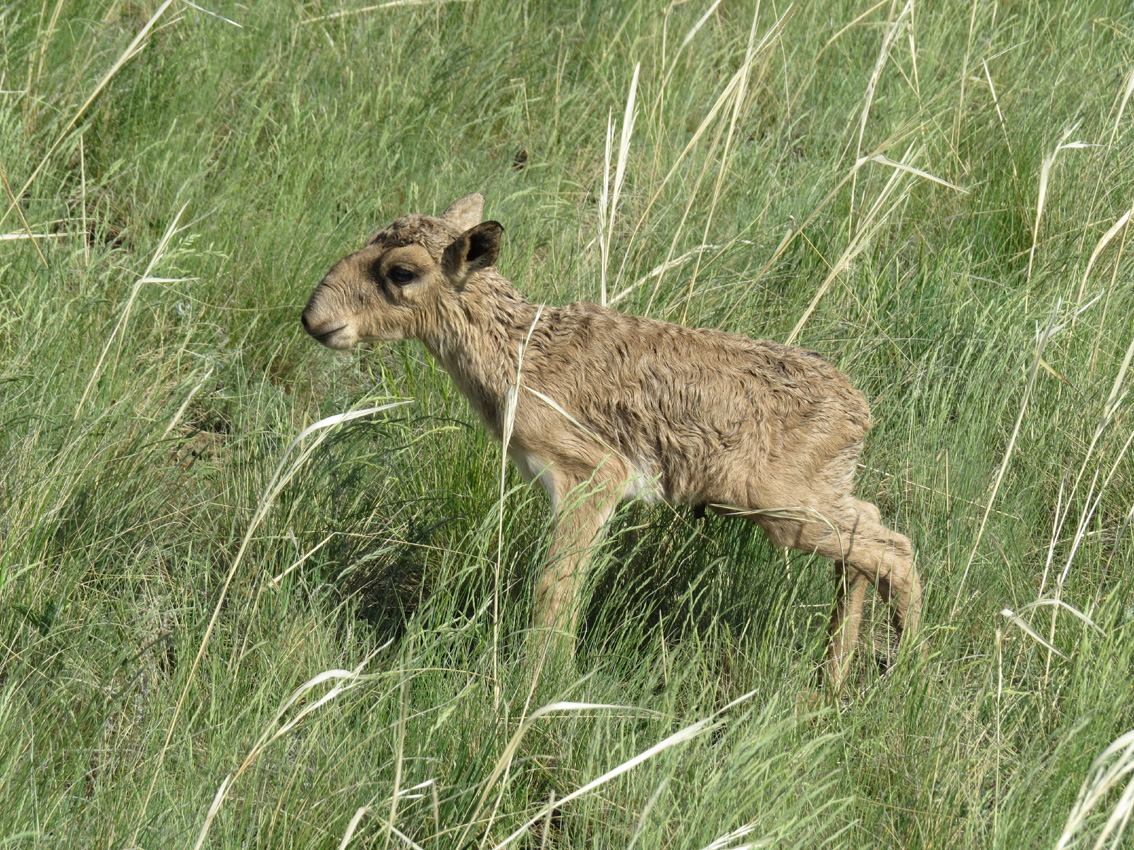
11. Saiga newborn standing
Although still wet, the newborn saiga is able to stand and even to walk.
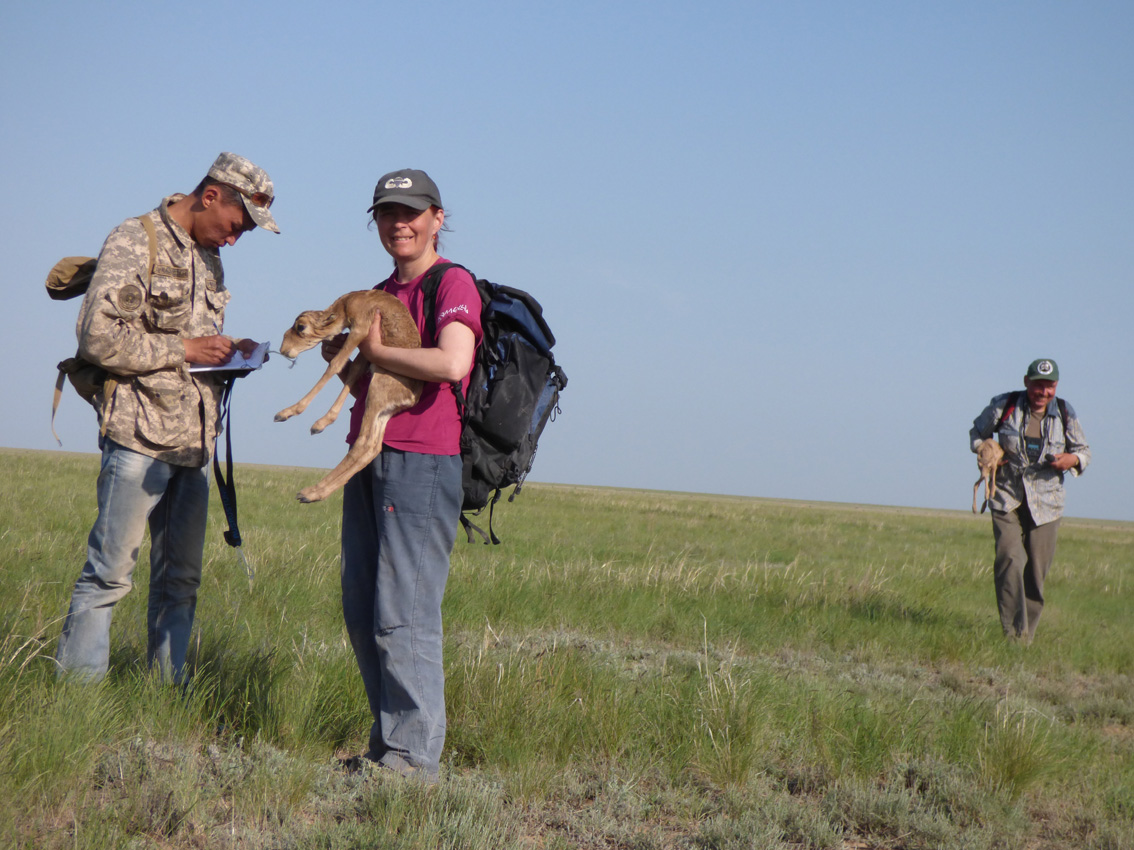
12. Catching saiga newborns for weighting
Saiga newborns soon after birth do not flee from humans. They are weighted on special scales and sexed by presence of tiny horns in males and by external sexual traits. In days of mass parturitions, the number of newborns at 10 km transect can reach two hundreds, so the tempo of work is very intensive.
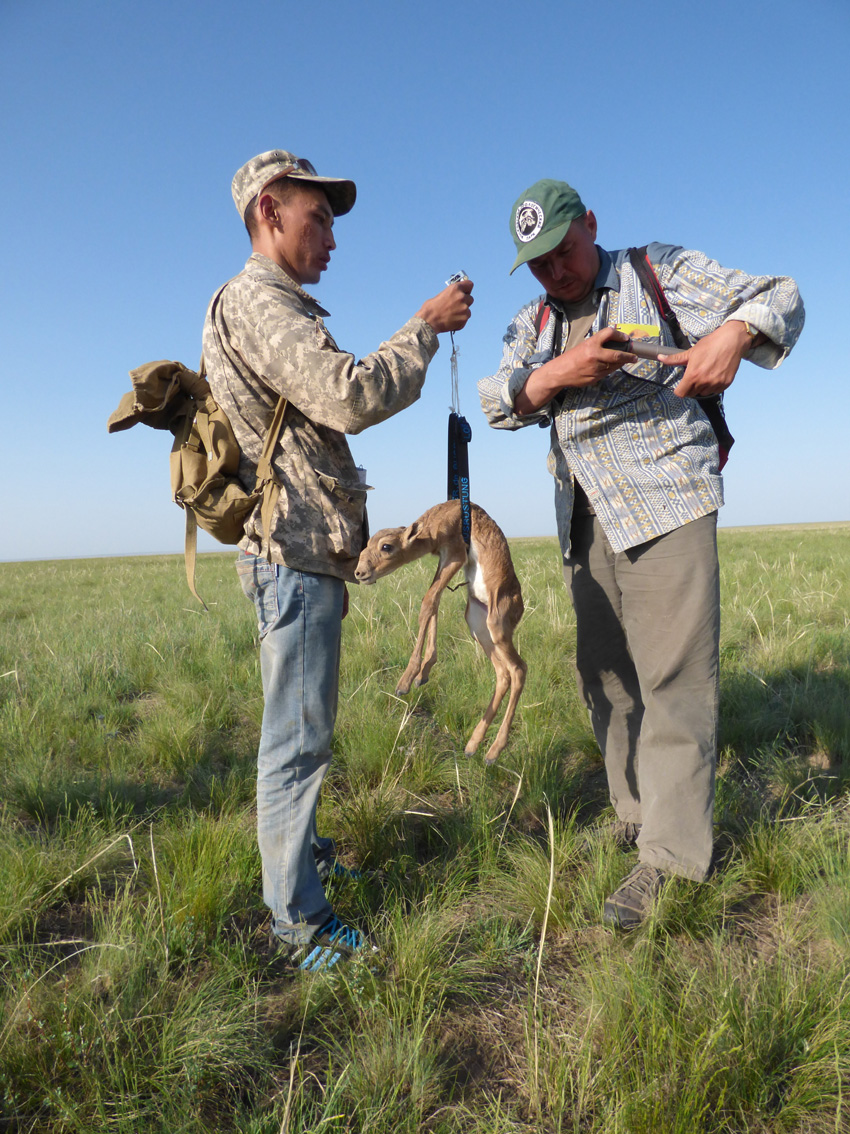
13. Weighting
After weighting and registering the GPS coordinates, the newborn is laid down back on the same place.
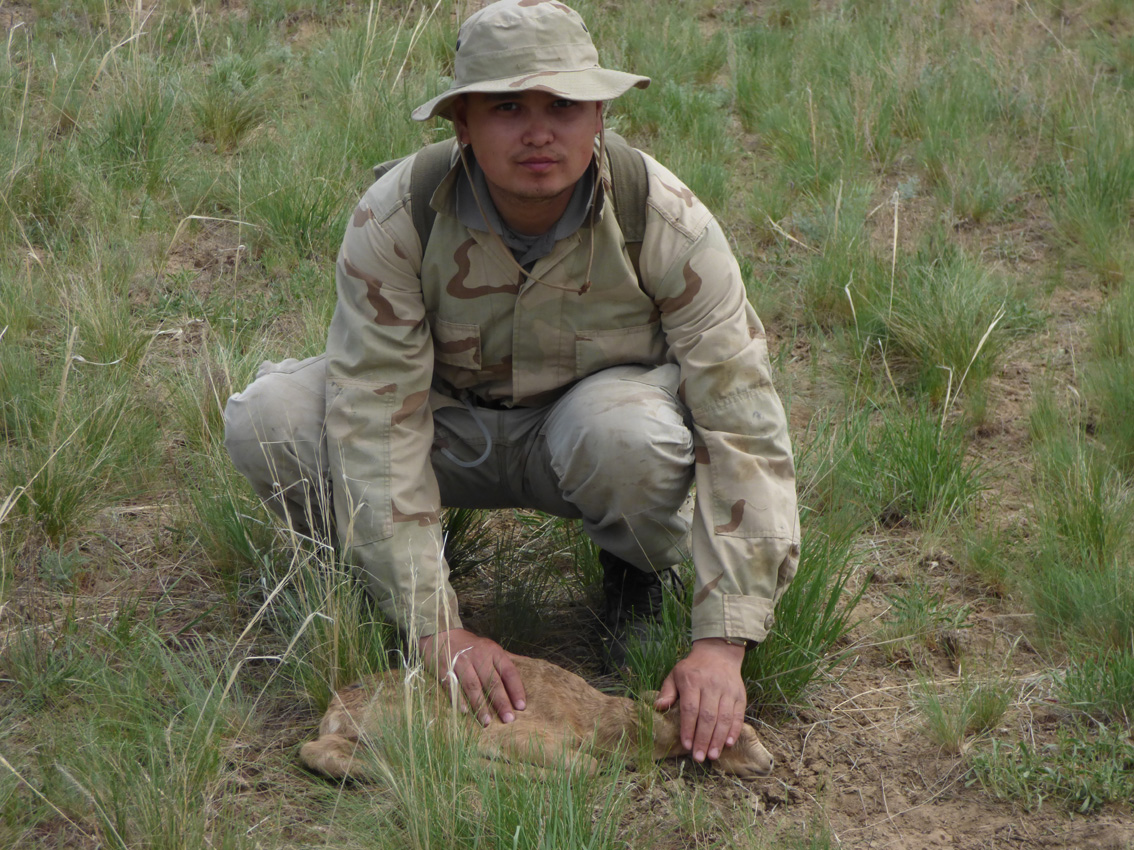
14. Laying down the newborn
This is the correct way of laying down the newborn saiga after the weighting procedure. The legs are carefully bent under the body, the eyes are tightly covered by the hand. As a rule, the young stays where it was laid down; this makes it less detectable for predators and save the energy than if it will walk.
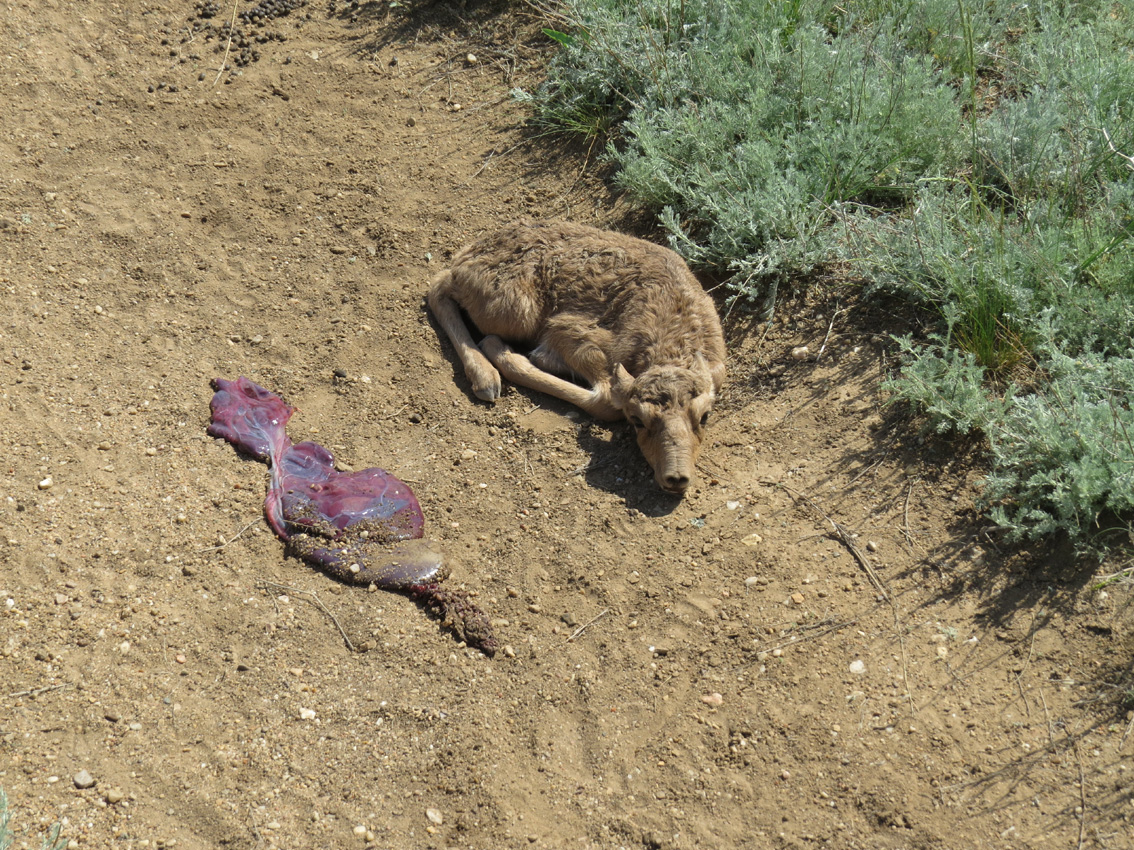
15. Newborn and the fresh placenta
Fresh placenta very often can be found near the saiga newborn, evidencing that a mother left the young in the same place where it was born. Surprisingly, but we practically did not see any terrestrial or arial predators, which would eat these placentas or threat the newborns.
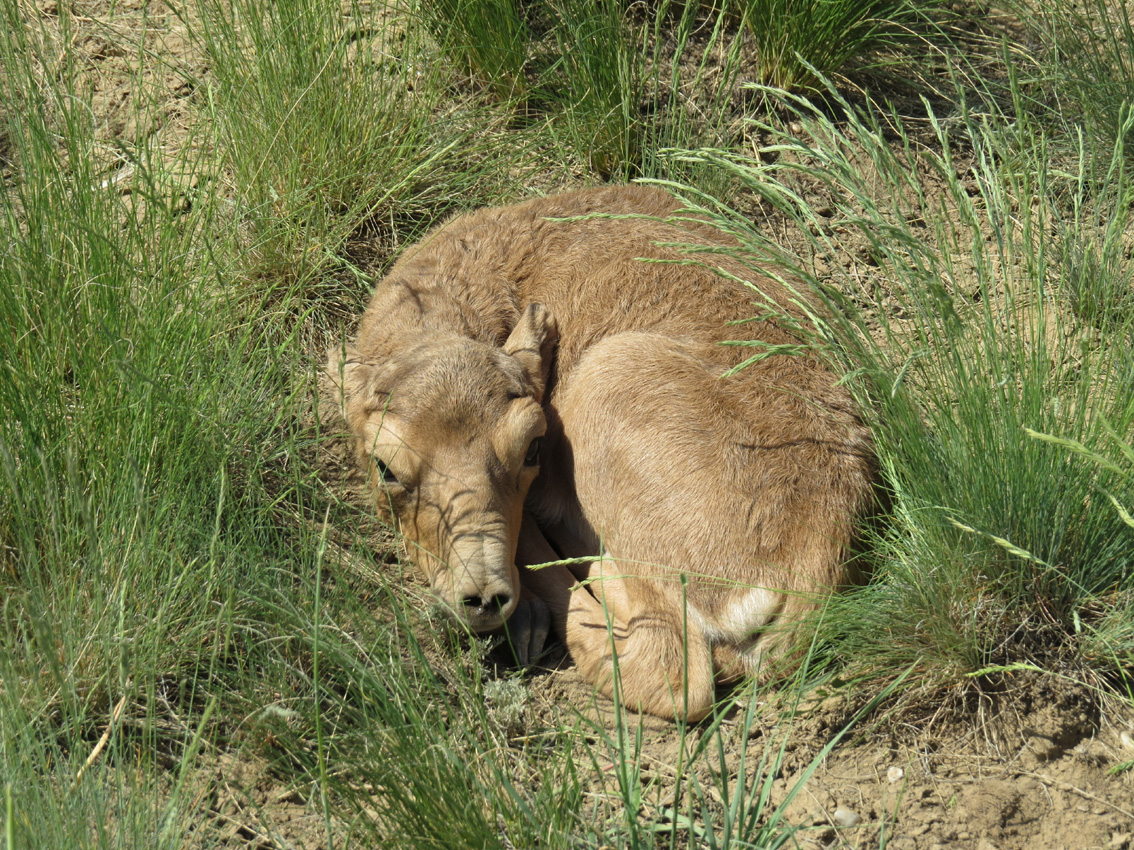
16. Newborn hider
This young has already dried and its fur has smoothed. To such young, is better to approach from behind, otherwise it will flee.
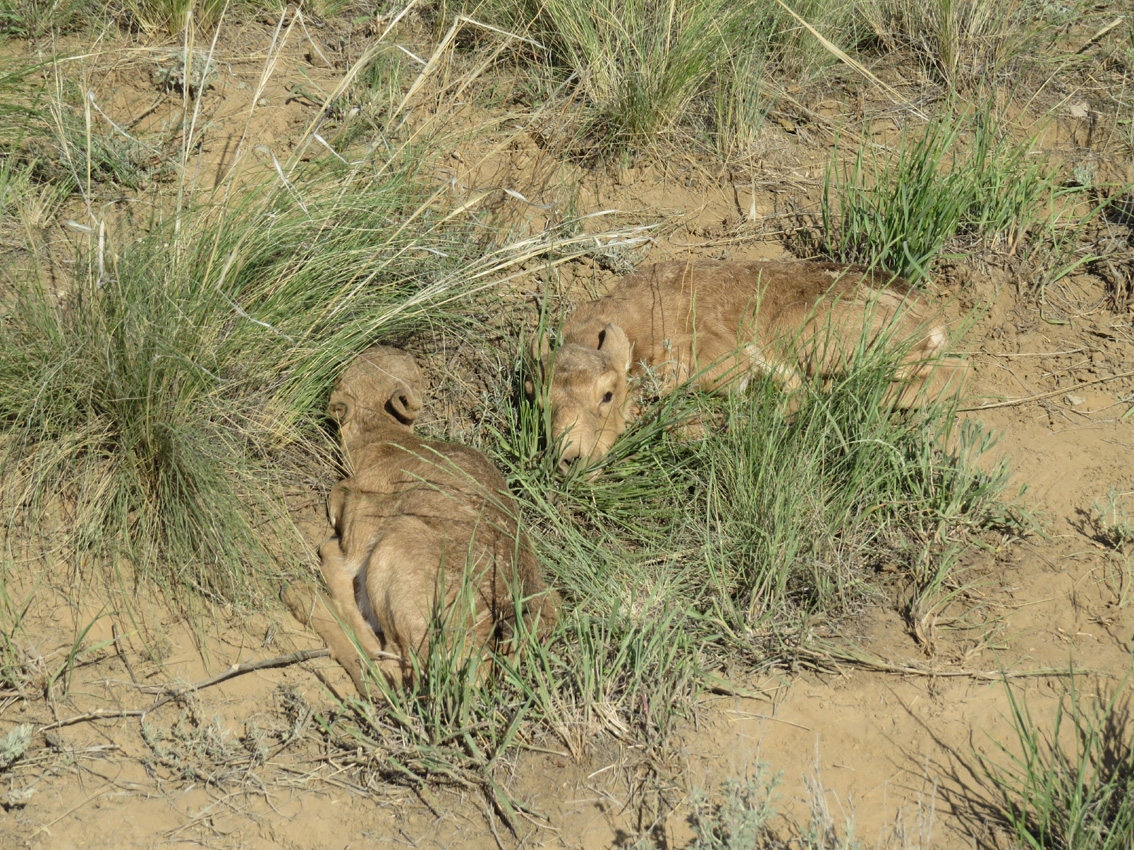
17. Twins
Saiga twins are norm rather than exclusion. Very often the twins lay nearby.
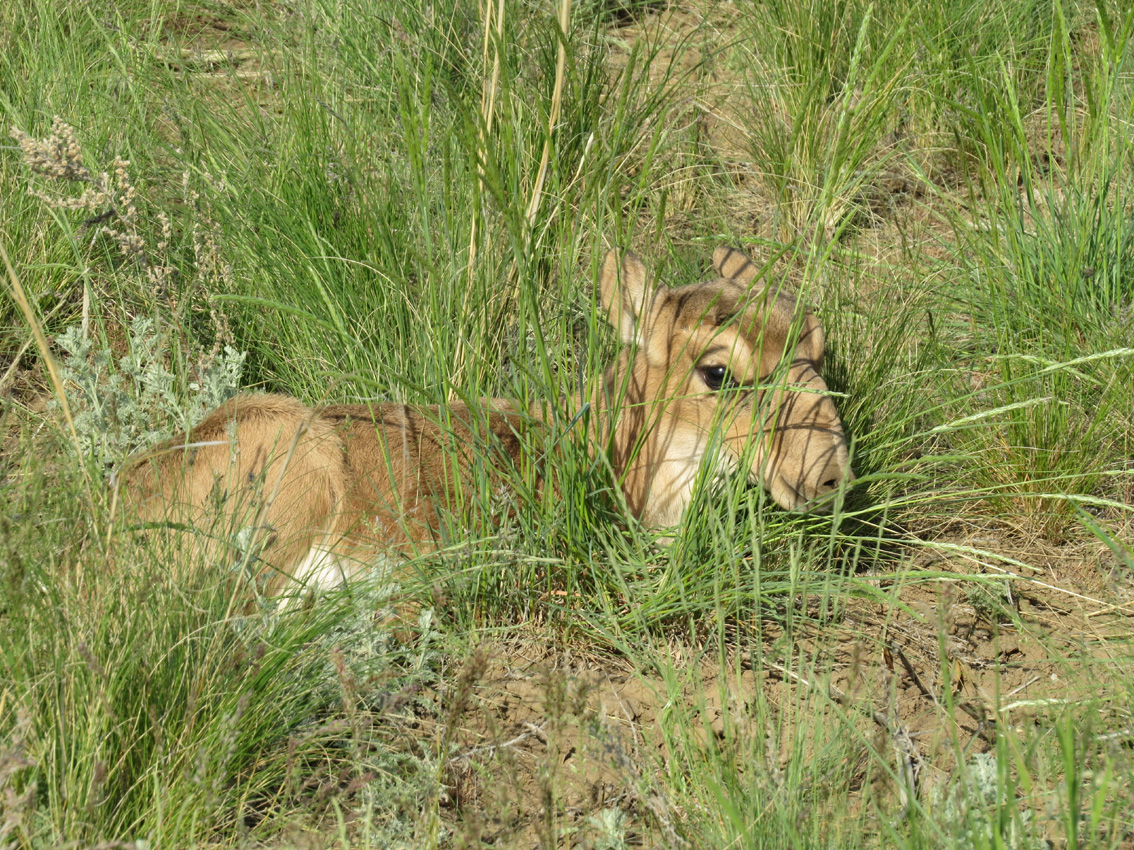
18. Laying newborn with raised head
At second day of saiga life, it raises a head when detecting a potential danger. Such young cannot be catch for the weighting, as it jumps up and runs away.
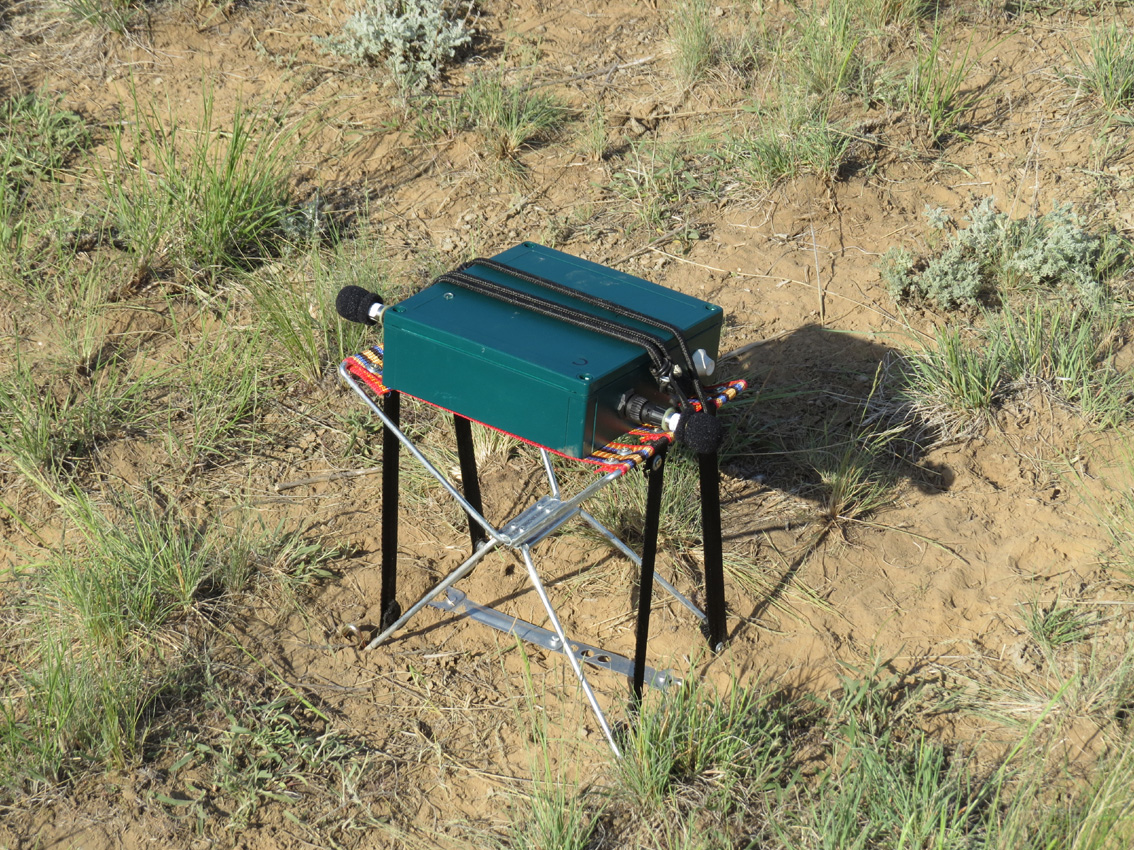
19. SongMeter
The unit for the automated sound recording in the absence of researchers: the SongMeter. We established a few such units on the transects during censuses. This allowed to record calls of the young towards their mothers and calls of mothers, appearing half hour after people coming out, looking for their offspring. Saiga_tatarica6_mother_calf_talk.wav

20. Females and their young
At the second-third day of life, many neonate saigas follow their mothers in herds. The mothers display their usual behaviour. They grazing, ambling or galloping, without any account for the following young. This is the case of the young to follow the mother, and they succeed in this perfectly.
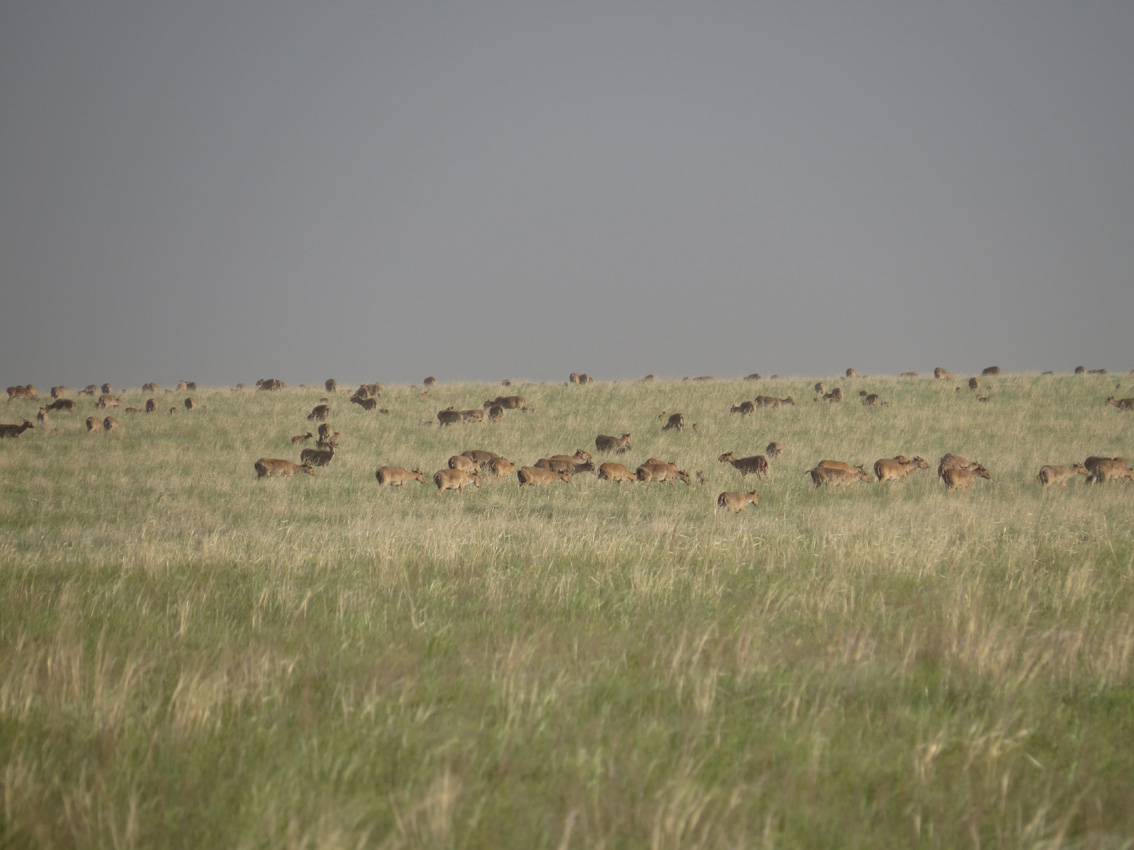
21. Female herd, circling around the transect
Females step aside when humans pass, and close down behind them, producing their low roaring sounds, addressed to their young. At dusk, the vocalizing increases, reminding the frog chorus. Saiga_tatarica7_saiga_herd.wav
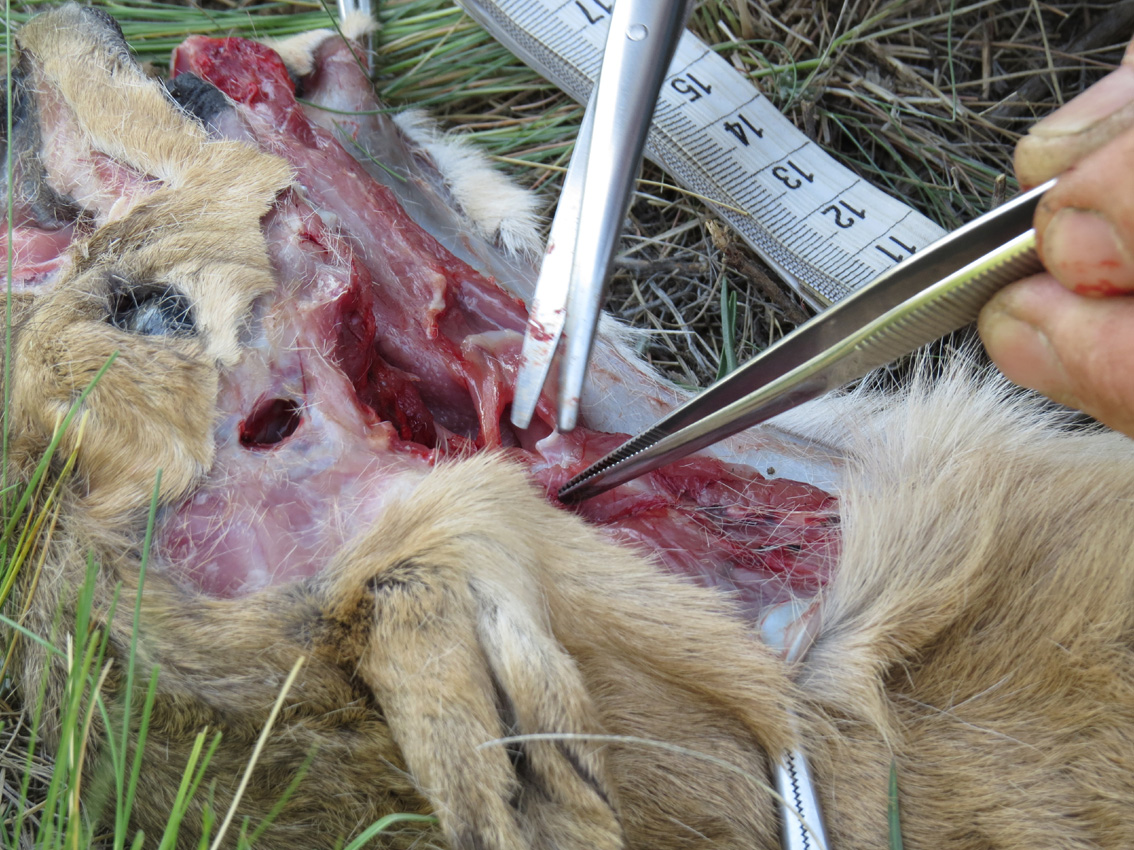
22. Anatomical dissection of a died neonate
Some weak newborns die soon after birth. When detected a died neonate, we measured the nasal and oral vocal tracts and sometimes made and anatomical dissection in order to confront the external measurements with the direct measurements of sound-producing structures of the vocal apparatus. These measurements are necessary for selecting the settings for analysis of acoustic traits in calls of live newborn saigas.
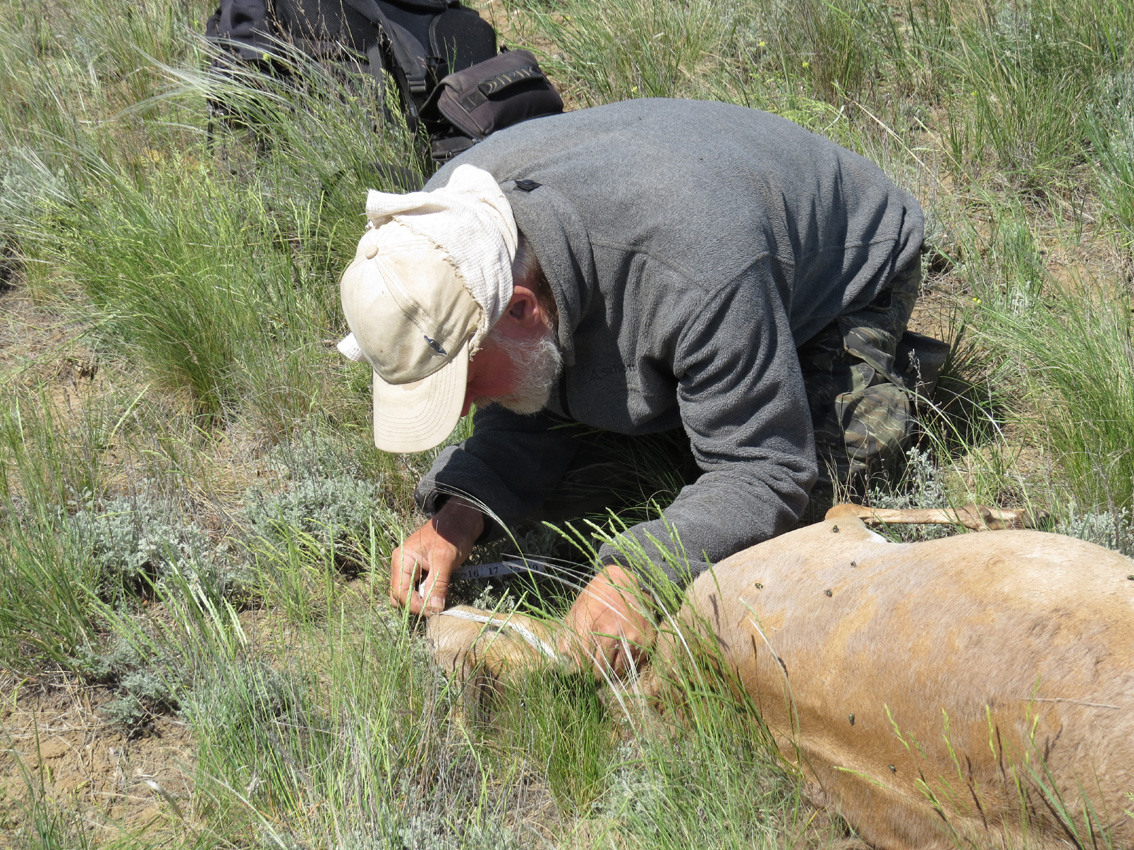
23. Measuring vocal tract of a died female
Some females die because of unsuccessful parturitions. When detecting a cadaver, we measured the nasal and vocal tracts to have starting points for subsequent selection of setting for acoustic analyses of calls recorded from adult females.
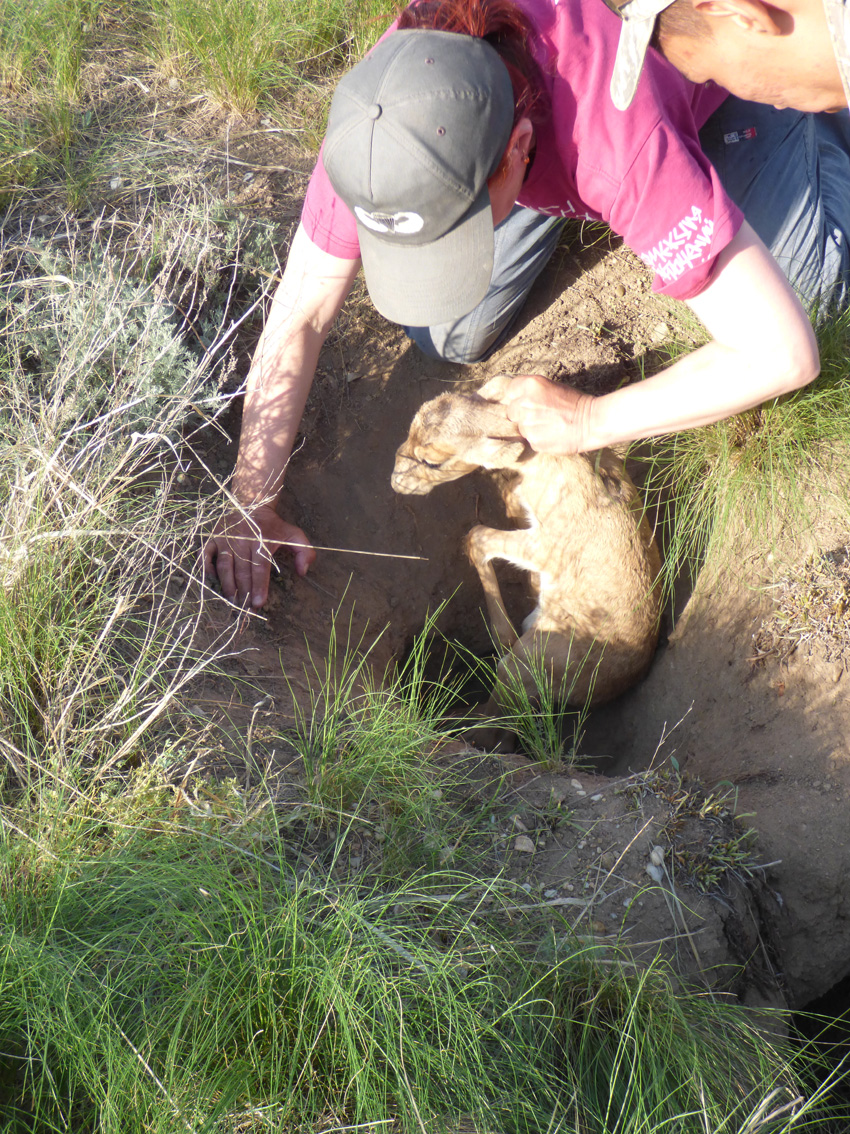
24. Rescue the saiga newborn from the badger burrow
This saiga newborn fell in the old badger burrow. Attempts to emerge, evidenced by the erased fur at withers, were unsuccessful. Probably, it fell recently, because it was still in good physical state when we took it out of the burrow. Meeting researchers saved its life, otherwise it was certainly dead. It was the male, further horn-bearer. After the weighting, it run out far from the guileful trap. Good luck to you, live long and happily!
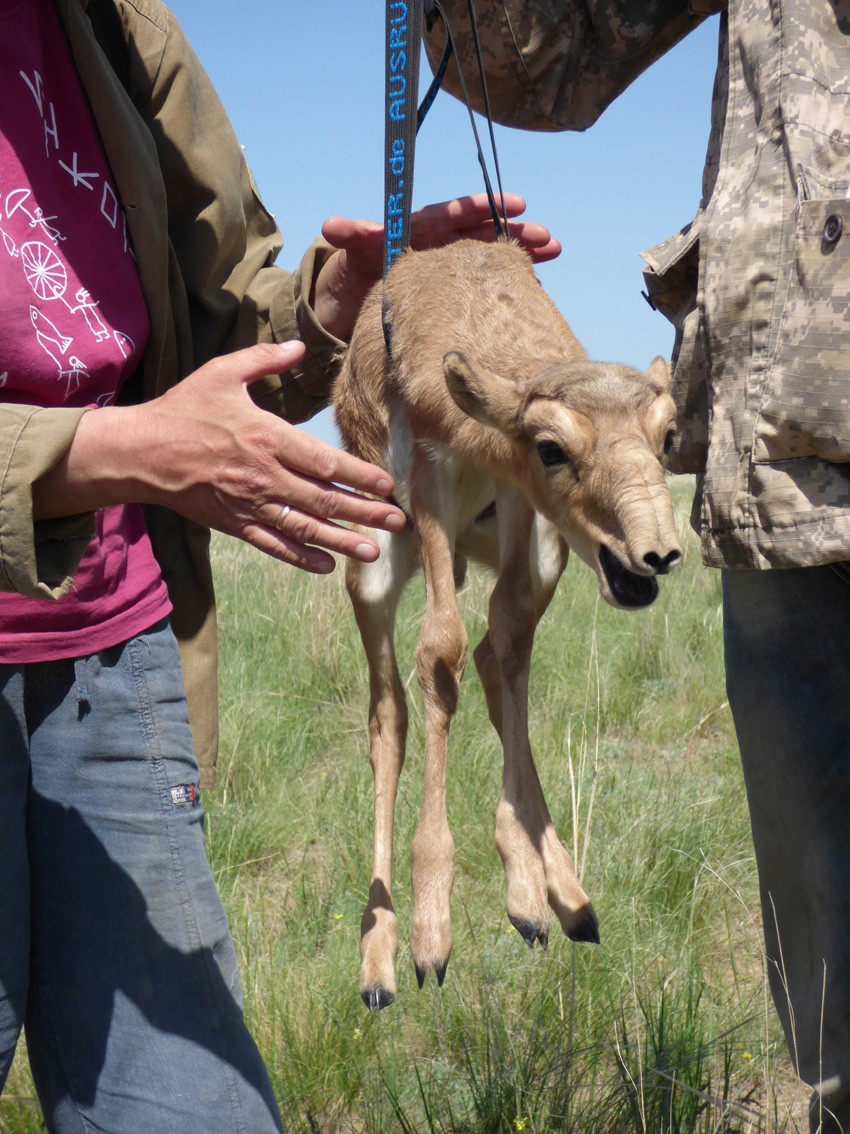
25. Newborn vocalizing during the weighting
If the newborn vocalized during the weighting, we have been recording its calls. Most newborn saigas behave calmly during the weighting, and only each eights one vocalizes.
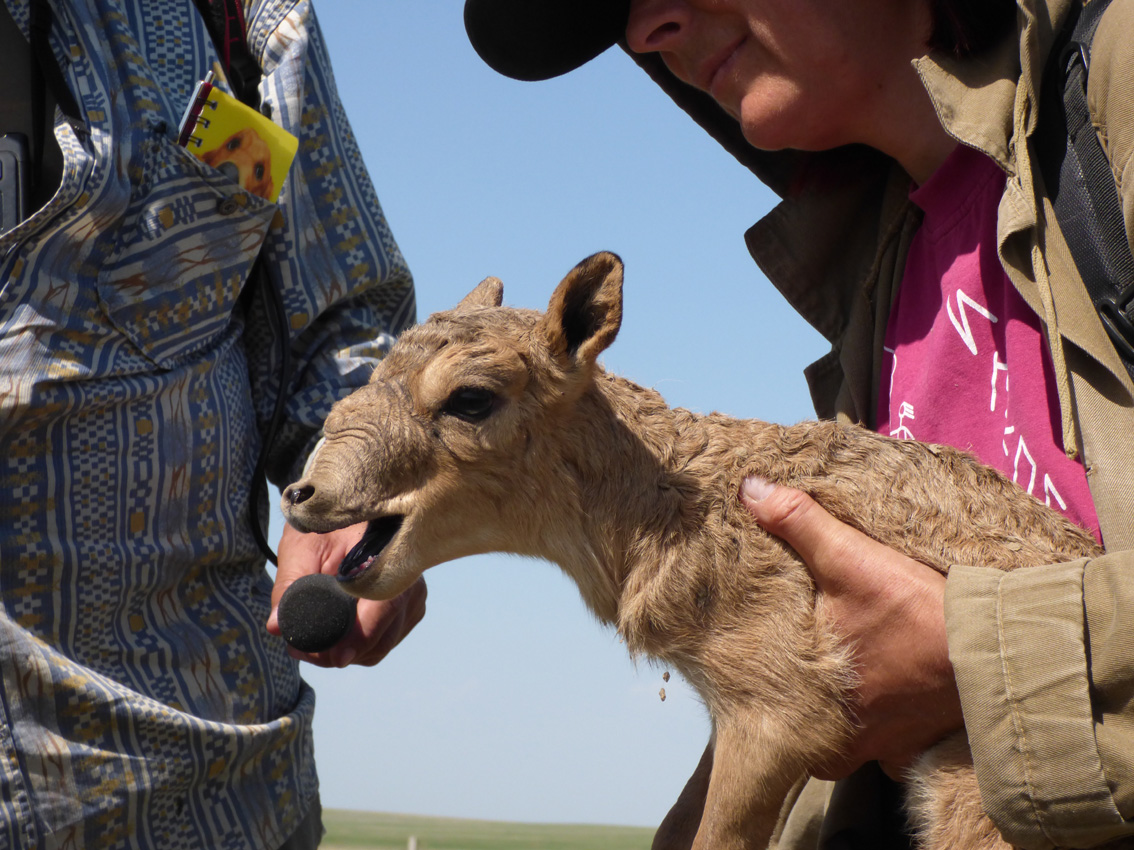
26. Call recording
Recorder and microphone are always ready. As a rule, from one to four newborn calls can be recorded. Saiga_tatarica8_ñalf_hand.wav
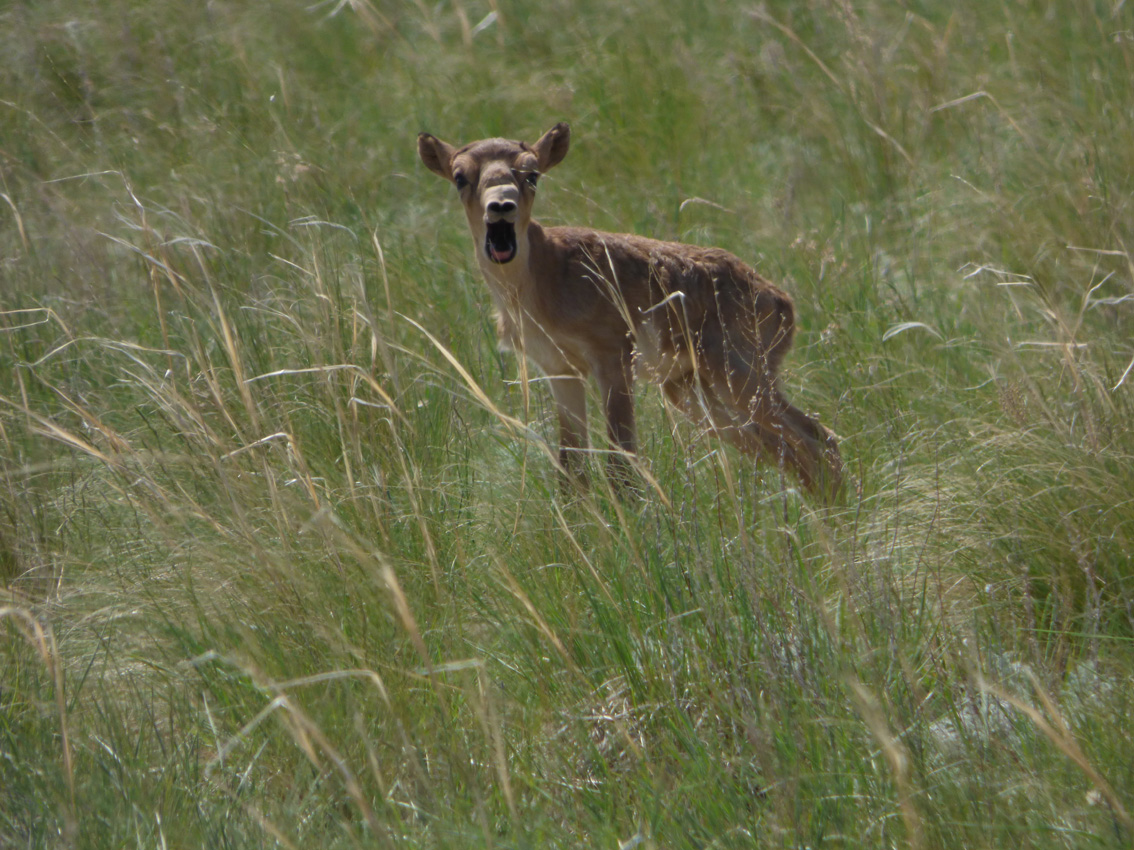
27. Newborn caller in the steppe
In nature, the saiga newborn is calling towards a mother with a widely opened mouth. Mother finds it by these calls and nurses. Saiga_tatarica9_ñalf_seperation.wav
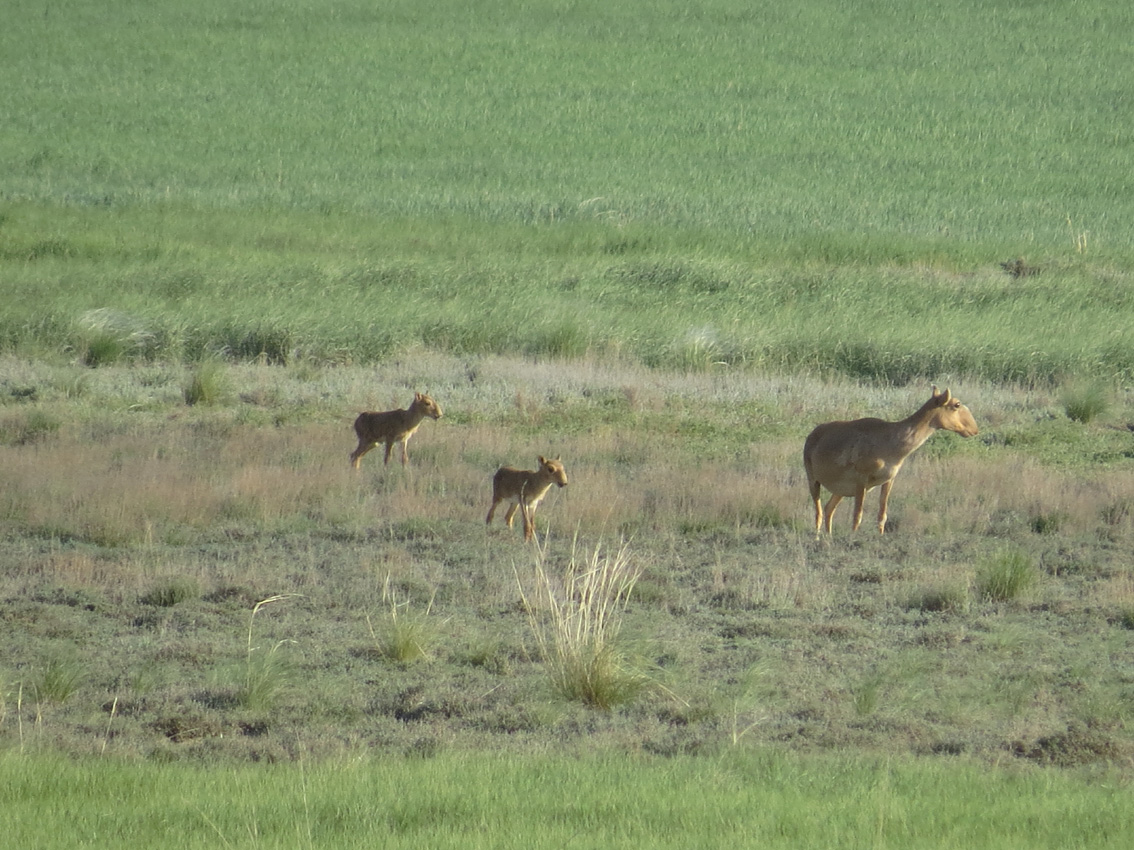
28. Female with a twin
During two weeks of the expedition, we weighed on the transects more than 500 saiga newborns and recorded calls from 70 of them. Using the SongMeters, we collected over 200 hours of recordings of mother and offspring contact calls. This material might help us to better understand the organization of vocal communication in this excellent animal.
:
|

